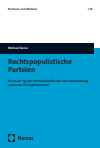Rechtspopulistische Parteien
Ein neuer Typ der Parteienfamilie oder eine Ansammlung nationaler Einzelphänomene?
Zusammenfassung
In dieser Publikation werden vier westeuropäische Vertreterinnen des Rechtspopulismus (FPÖ, AfD, PVV, RN) auf Basis von Ideologie, Historie, Organisation, Elektorat und europäischer Kooperation verglichen. Der Autor kommt zu dem Schluss, dass dies mehr als eine Familie wider Willen ist. Die, in ihrem Umfang einzigartige, Analyse sieht im Rechtspopulismus den ideologischen Kern einer Verwandtschaft. Eine stetige Annäherung rechtspopulistischer Akteur:innen lässt sich auch aus der zunehmenden Kooperationsbereitschaft auf europäischer Ebene ablesen. Die qualitative Inhaltsanalyse von Programminhalten, die den Kern der Publikation ausmacht, fördert jedoch auch zahlreiche Unterschiede, etwa bei der Wirtschafts- oder Klimapolitik, zutage.
Abstract
In this publication, the author compares four representatives of Western European right-wing populist parties (FPÖ, AfD, PVV, RN) based on their ideologies, histories, organisation, voter bases and their cooperation in Europe. He concludes that they constitute more than an unintended family. This uniquely extensive comparison considers right-wing populism the ideological core of their relation to each other. Growing reconciliation among right-wing populist parties can also be seen in their increasing willingness to cooperate within the European Parliament. However, a qualitative analysis of their party programmes, which forms the main part of this study, reveals significant differences between them, for example in terms of the parties’ economic and environmental policies.
Schlagworte
AfD climate policy comparison Europäische Kooperation economic policy FPÖ European cooperation Ideologie ideology Klimapolitik Kooperationsbereitschaft parties Parteien politics right-wing populism Politik Programminhalte Western Europe PVV willingness to cooperate Rechtspopulismus RN Vergleich Westeuropa Wirtschaftspolitik- 15–28 1. Einleitung 15–28
- 55–92 3. Populismus 55–92
- 201–362 5. Programmvergleich 201–362
- 389–398 7. Schluss 389–398
- 399–426 Literaturverzeichnis 399–426

